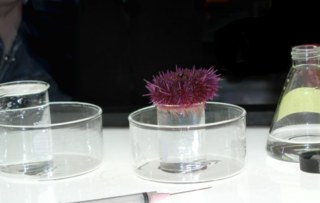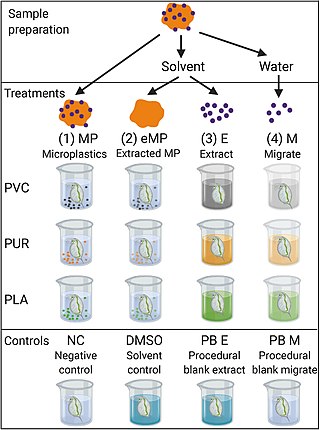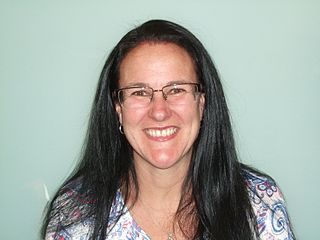Related Research Articles

Formaldehyde ( for-MAL-di-hide, fər-) (systematic name methanal) is an organic compound with the chemical formula CH2O and structure H−CHO, more precisely H2C=O. The compound is a pungent, colourless gas that polymerises spontaneously into paraformaldehyde. It is stored as aqueous solutions (formalin), which consists mainly of the hydrate CH2(OH)2. It is the simplest of the aldehydes (R−CHO). As a precursor to many other materials and chemical compounds, in 2006 the global production of formaldehyde was estimated at 12 million tons per year. It is mainly used in the production of industrial resins, e.g., for particle board and coatings. Small amounts also occur naturally.

Water pollution is the contamination of water bodies, usually as a result of human activities, so that it negatively affects its uses. Water bodies include lakes, rivers, oceans, aquifers, reservoirs and groundwater. Water pollution results when contaminants mix with these water bodies. Contaminants can come from one of four main sources: sewage discharges, industrial activities, agricultural activities, and urban runoff including stormwater. Water pollution is either surface water pollution or groundwater pollution. This form of pollution can lead to many problems, such as the degradation of aquatic ecosystems or spreading water-borne diseases when people use polluted water for drinking or irrigation. Another problem is that water pollution reduces the ecosystem services that the water resource would otherwise provide.

Environmental remediation is the cleanup of hazardous substances dealing with the removal, treatment and containment of pollution or contaminants from environmental media such as soil, groundwater, sediment. Remediation may be required by regulations before development of land revitalization projects. Developers who agree to voluntary cleanup may be offered incentives under state or municipal programs like New York State's Brownfield Cleanup Program. If remediation is done by removal the waste materials are simply transported off-site for disposal at another location. The waste material can also be contained by physical barriers like slurry walls. The use of slurry walls is well-established in the construction industry. The application of (low) pressure grouting, used to mitigate soil liquefaction risks in San Francisco and other earthquake zones, has achieved mixed results in field tests to create barriers, and site-specific results depend upon many variable conditions that can greatly impact outcomes.

Microcystins—or cyanoginosins—are a class of toxins produced by certain freshwater cyanobacteria, commonly known as blue-green algae. Over 250 different microcystins have been discovered so far, of which microcystin-LR is the most common. Chemically they are cyclic heptapeptides produced through nonribosomal peptide synthases.

Carbofuran is a carbamate pesticide, widely used around the world to control insects on a wide variety of field crops, including potatoes, corn and soybeans. It is a systemic insecticide, which means that the plant absorbs it through the roots, and from there the plant distributes it throughout its organs where insecticidal concentrations are attained. Carbofuran also has contact activity against pests. It is one of the most toxic pesticides still in use.

In organic chemistry, chlorpyrifos (CPS), also known as chlorpyrifos ethyl, is an organophosphate pesticide that has been used on crops, animals, and buildings, and in other settings, to kill several pests, including insects and worms. It acts on the nervous systems of insects by inhibiting the acetylcholinesterase enzyme. Chlorpyrifos was patented in 1966 by Dow Chemical Company.

Aquatic toxicology is the study of the effects of manufactured chemicals and other anthropogenic and natural materials and activities on aquatic organisms at various levels of organization, from subcellular through individual organisms to communities and ecosystems. Aquatic toxicology is a multidisciplinary field which integrates toxicology, aquatic ecology and aquatic chemistry.

Atrazine is a chlorinated herbicide of the triazine class. It is used to prevent pre-emergence broadleaf weeds in crops such as maize (corn), soybean and sugarcane and on turf, such as golf courses and residential lawns. Atrazine's primary manufacturer is Syngenta and it is one of the most widely used herbicides in the United States, Canadian, and Australian agriculture. Its use was banned in the European Union in 2004, when the EU found groundwater levels exceeding the limits set by regulators, and Syngenta could not show that this could be prevented nor that these levels were safe.

Ecotoxicology is the study of the effects of toxic chemicals on biological organisms, especially at the population, community, ecosystem, and biosphere levels. Ecotoxicology is a multidisciplinary field, which integrates toxicology and ecology.

Environmental toxicology is a multidisciplinary field of science concerned with the study of the harmful effects of various chemical, biological and physical agents on living organisms. Ecotoxicology is a subdiscipline of environmental toxicology concerned with studying the harmful effects of toxicants at the population and ecosystem levels.

Clothianidin is an insecticide developed by Takeda Chemical Industries and Bayer AG. Similar to thiamethoxam and imidacloprid, it is a neonicotinoid. Neonicotinoids are a class of insecticides that are chemically similar to nicotine, which has been used as a pesticide since the late 1700s. Clothianidin and other neonicotinoids act on the central nervous system of insects as an agonist of nAChR, the same receptor as acetylcholine, the neurotransmitter that stimulates and activating post-synaptic acetylcholine receptors but not inhibiting AChE. Clothianidin and other neonicotinoids were developed to last longer than nicotine, which is more toxic and which breaks down too quickly in the environment.

Thiamethoxam is the ISO common name for a mixture of cis-trans isomers used as a systemic insecticide of the neonicotinoid class. It has a broad spectrum of activity against many types of insects and can be used as a seed dressing.

Frédéric Yves Bois is a French biological scientist working in toxicology and bioinformatics. He is currently Senior Scientific Advisor at Simcyp, a Certara-owned company.
Toxicological databases are large compilations of data derived from aquatic and environmental toxicity studies. Data is aggregated from a large number of individual studies in which toxic effects upon aquatic and terrestrial organisms have been determined for different chemicals. These databases are then used by toxicologists, chemists, regulatory agencies and scientists to investigate and predict the likelihood that an organic or inorganic chemical will cause an adverse effect on exposed organisms.

Catherine K. King is an Australian ecotoxicologist who studies sub-Antarctic and Antarctic regions, with a focus on climate change and the impacts of contaminants and environmental stressors in terrestrial and marine ecosystems.

The Integrated Risk Information System (IRIS) is an environmental assessment program operated by the U.S. Environmental Protection Agency (EPA). The IRIS program is focused on risk assessment, and not risk management.

Michael L. Dourson is an American toxicologist and Director of Science at the nonprofit organization, Toxicology Excellence for Risk Assessment. He was formerly a senior advisor to the Administrator of EPA, and prior to that, a professor at the Risk Science Center at the University of Cincinnati College of Medicine. Prior to joining the University of Cincinnati, he was founder and president of the nonprofit Toxicology Excellence for Risk Assessment. Earlier in his career, he was employed by the Environmental Protection Agency Environmental Criteria and Assessment Office, among other assignments.

Deborah Liebl Swackhamer was an environmental chemist and professor emerita at the University of Minnesota in Minneapolis. Swackhamer applied her expertise in studying the effects of exposure to toxic chemicals, as well as the processes that spread those chemicals, to developing policies that address exposure risks.
Environmental Toxicology and Chemistry is a monthly peer-reviewed scientific journal covering environmental toxicology and environmental chemistry. It was established in 1982 and is published by Wiley-Blackwell in conjunction with the Society of Environmental Toxicology and Chemistry. The founding editor-in-chief was C.H. Ward, and the current one is G.A. Burton, Jr.. According to the Journal Citation Reports, the journal has a 2021 impact factor of 4.218, ranking it 117th out of 279 journals in the category Environmental sciences and 29th out of 94 in the category Toxicology.
Valery E. Forbes is an American ecologist and professor specializing in environmental toxicology. Since the start of the 2022-2023 academic season, she has been the Dean of the Charles E. Schmidt College of Science at Florida Atlantic University. Her research expertise is in ecotoxicology, where she primarily studies effects of environmental stresses on organisms at different levels of biological organization.
References
- ↑ US EPA, ORD (10 May 2019). "Society of Environmental Toxicology and Chemistry (SETAC): Environmental Risk Assessment of PFAS". US EPA. Retrieved 28 August 2019.
- ↑ "Environmental Toxicology and Chemistry". setac.onlinelibrary.wiley.com. Retrieved 28 August 2019.
